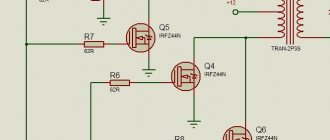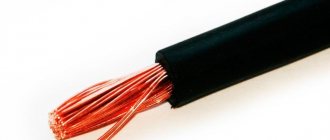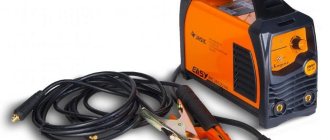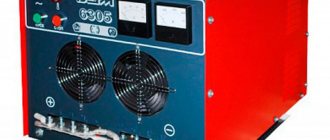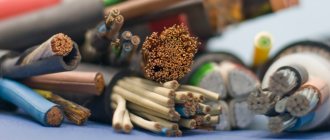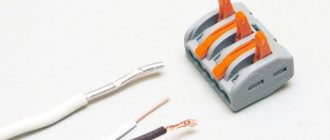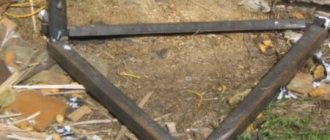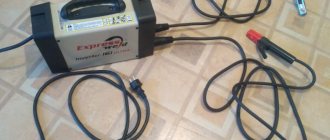Anyone can independently install electrical wiring with copper cores. According to the rules, the wires are connected with terminals, soldered or welded. It is more convenient to use a device for welding copper wires in distribution boxes and panels. The copper twist melts in a matter of seconds under the action of an electric arc. After this she is isolated. Such a connection will last a long time and will not create additional resistance.
Having a small welding device at home, you can carry out third-party orders for the installation or repair of copper wires. Many craftsmen make welders themselves.
What equipment is needed for welding copper wires?
To weld prepared copper cables you will need an inverter and electrodes.
Features of copper: fluidity, high thermal conductivity, ability to absorb gases - require experience and skill from the performer.
Electrodes used
For welding copper wires, two types of electrodes are used: carbon or graphite with a copper coating:
- the destruction temperature of the electrode material is more than 3800ºС, and copper melts at 1080ºС, which allows their repeated use;
- rapid heating of the rod material to the copper liquefaction temperature;
- During welding, the carbon rod does not stick to the wires;
- 5-10 A is a sufficient, although small, current for a stable arc discharge.
Features of using carbon electrodes
The electrodes are made from black electrical carbon pressed into a rod shape. Its ends are beveled. Even with a very low welding current, a high temperature occurs at the tip of the electrode.
A carbon electrode is used when it is not possible to weld with a graphite element. You need to work very carefully to prevent the insulation from overheating. Carbon electrodes are commonly used in low power welders.
When working with carbon electrodes, the following features must be taken into account:
- the welding site is fragile , can oxidize and have a porous structure;
- Due to the high arc temperature, the electrode is consumed faster;
- It is more difficult to work with a carbon rod electrode than with a graphite electrode ; practical skills are required.
Approximate cost of carbon electrodes on Yandex.market
Graphite welding electrodes
Graphite electrode rods are gray in color with a slight metallic tint. The crystalline structure of carbon is not subject to oxidation. When welded, crystalline graphite forms a corrosion- and temperature-resistant compound. These electrodes are advantageous to use and are cheaper than carbon electrodes. The rods do not crack and last a long time.
If necessary, it is possible to replace it with improvised graphite products - brushes from commutator motors, rods of disassembled batteries. In the case of using a readily available graphite replacement without copper plating, an alligator clip is used instead of a conventional holder.
Approximate cost of graphite electrodes on Yandex.market
Graphite electrodes are more often used with inverters that regulate the welding current.
Inverters
For welding, a DC or AC device with a voltage in the range of 12-36 V is suitable; current adjustment is required.
The choice of model is based on the intended modes of use of the device: from half-hour work without a break to many hours of intensive work.
If the device will be used infrequently, then a model that provides a maximum welding current of 150 A and a power of about 500 W is suitable. This is enough for welding strands with a cross-section of 20-25 mm².
Approximate cost of inverters for welding on Yandex.market
Inverter device
The universal inverter is designed for many types of work; it is suitable for welding aluminum and copper strands.
Domestic welders:
- "Resanta" SAI-160 produces current in a wide range from 10 to 160 A, device weight 4.5 kg, cost 6.3 thousand;
- “Svarog” ARC 160 Easy Z213 H produces current in the range from 10 to 160 A, weighs 4 kg, operates from a standard 220 V network, costs 9 thousand.
Imported inverters:
- The Italian “Quattro elementia 160 nato” 643-255, assembled in China, runs on a 220 V network. It costs about 6 thousand, weighs almost 5 kg.
- American "PFrionMax Welder DC-200 C", released by the Chinese branch. Weighs 4.5 kg. Equipped with a carrying strap and operates silently. Cost from 7.5 to 9.6 thousand depending on the configuration.
- The German “Fubag IQ 160” is small-sized but heavy, weighing almost 7 kg. Designed to operate from a network from 150 to 240 V, it is not afraid of voltage “sagging”. Produces operating current from 10 to 160 amperes. Equipped with two power wires, costs 7 thousand.
For welding with inverters, a copper-plated carbon rod is used, it is also called a copper-carbon electrode. Industrial inverters for copper wires are large and heavy. To work with electricians, choose small devices operating from a 220 V network, equipped with a carrying belt. Inverters differ from transformers in their stable arc and additional functions that simplify welding.
Recommended welding current modes for different conductors
The magnitude of the welding current depends on the cross-section size and the number of strands in the twist: the thicker the twisted bundle, the greater the current value must be set on the welding machine:
- 2 cores, cross section of each 1.5 mm² - 70 A;
- 3 cores, cross section of each 1.5 mm² - 80-90 A;
- 2-3 cores, cross section of each 2.5 mm² - 80-100 A;
- 3-4 cores, cross section of each 2.5 mm² - 100-120 A.
The specified welding current modes are indicative. Wires from different manufacturers differ in chemical composition and declared cross-section, and welding devices also differ in their characteristics. Therefore, it is better to select the value of the welding current practically on a small section of the same wire. When choosing a mode experimentally, the optimal one will be when the arc is stable and the tip of the electrode does not stick to the welding site.
For modern inverter-type devices:
- stable welding discharge , ensuring high-quality welding work;
- When welding, liquid metal does not splash;
- the arc does not blind the welder due to the low melting point of copper;
- inverters are not heavy, their dimensions are small , which allows them to be carried to the installation site on a belt.
Specifics of welding work with aluminum wires
The most reliable method of welding the twist end is considered to be the spot method. The advantage of this method is that during welding, the metal of the conductors merges. And if with other options a transition resistance of the contact area may arise, then with the point mode this does not happen. Electrically welded wires are durable and do not require periodic maintenance, inspection or repair.
Possible complications of work
When working with aluminum cables, a number of difficulties arise:
Welding aluminum wires
- It is difficult to make a high-quality connection due to the oxide film that rapidly forms on the metal. This makes it difficult to obtain a uniform connection of wires.
- The increased fluidity of aluminum in the molten state makes it difficult to achieve good quality welds when welding tight joints.
- Metal shrinkage should be taken into account. But the obtained result can always be improved with additional twist processing.
Handling aluminum cables at home is a difficult task. The correct welding mode must be carefully selected. There is a misconception that inverters have a constant output voltage.
In fact, the device is equipped with an electric current control and the voltage can be lowered, depending on the diameter of the wire:
| Voltage, V | Diameter of wires, mm |
| 25 | 0,5–1,0 |
| 20 | 0,3–0,5 |
| 12 | 0,1–0,3 |
| 10 | 0,05–0,1 |
You should also choose the correct diameter of the electrode, depending on the area of the core:
| Metal thickness, mm | 1–3 | 3–4 | 4–5 | 5–6 | 6–8 | 8–11 | 12–15 | 15–18 |
| Welding electrode diameter, mm | 1,0–1,5 | 1,6–2,0 | 2,0–2,4 | 2,5–3,1 | 3,2–3,9 | 4,0–4,9 | 5,0–5,9 | 6.0 or more |
| Recommended current values, A | 20–60 | 50–90 | 60–100 | 80–120 | 110–150 | 140–180 | 180–220 | 220–260 |
The magnitude of the welding electric current varies depending on the number of wires and their diameter:
| Current value, A | Number of transactions | Wire cross-section, mm |
| 70 | 2 | 1,5 |
| 80 | 3 | 1,5 |
| 100 | 2 | 2,5 |
| 120 | 4 | 2,5 |
When welding with alternating current, it is difficult to achieve a good result and it takes a lot of skill to get a quality connection. That is why a non-professional will need a good device to master the basics.
Related video: A simple way to weld twists
Publications on the topic
How to independently repair inverter-type welding machines
Features of welding thin metal with an inverter
Methods for cooking stainless steel with an inverter at home
Preparatory work
Before you start working with the wires, you need to check again that there is no voltage on them.
For further work you will need a knife or special cutting tools, emery cloth, solvent, pliers or pliers, insulating tape or heat-shrinkable tubing. If heat-shrinkable tubing is used for insulation, it is very convenient to use a hair dryer, which gives a tight fit with the film.
To obtain a high-quality connection, preparatory work is carried out in the following sequence:
- Carefully remove a section of the insulating coating of at least 7 cm from the core for a core with a cross section of 1.5 mm² . If the wires are thicker, then for every 0.5 mm² of core diameter, reduce 5 mm of insulation. The cutting is carried out along the conductor with a knife or a special tool - a stripper;
- bare areas of the wire are cleaned with emery cloth;
- the surface of the conductors is degreased with acetone or white spirit;
- carefully, so as not to damage the wires, twist them into a flagellum with your hands or pliers , trying to ensure they fit snugly against each other;
- use wire cutters or mounting scissors to cut off the end of the harness to align the wires.
Process technology and methods for welding wires
There are various technologies for connecting cores: using terminal blocks, clamps, crimping, soldering or welding - all of them are described in detail in the Electrical Installation Rules (ELR) and are used in practice. The welding method is recognized as the most reliable of all.
Fig.1
The conductors welded together form a homogeneous core with a record low contact resistance, which completely eliminates their heating and guarantees fire safety. Copper wire is mainly used for electrical wiring.
To perform welding, you need a device with direct or alternating current voltage of 12-36 V, with the ability to regulate the current. This condition is met by an inverter for welding copper wires (Fig. 1).
Considering its considerable cost, some craftsmen use a transformer instead (Fig. 2) or a home-made welding machine.
In this article we will not talk about how to make a welder yourself. The model may depend on the raw materials the craftsman has at hand and on his knowledge and skills.
Rice. 2
To obtain a reliable connection of two or more conductors (cores), proven technology is used. The procedure is as follows:
- A piece of insulation 60-80 mm long is carefully removed from the core using a knife or a special tool (stripper, stripper, puller, etc.). The cutting is carried out exclusively along the conductor, so as not to accidentally make an incision.
- Thoroughly clean the surface until it is shiny.
- The exposed area of the conductor is treated with emery cloth.
- Moisten a clean cloth with acetone or white spirit and wipe the surfaces of the conductors. Borax is used for copper wires.
- Perform twisting. When performing twisting, you should not be careless. You can’t just twist the wires into a “bundle” or weave them into a “braid”. The work is carried out carefully so as not to break the conductors.
- Align the ends and cut the end evenly so that it has a flat cut. To do this, use mounting scissors or ordinary wire cutters.
- Welding of wires twisted into a single element is performed at the ends of the conductors and takes 1-2 seconds, depending on the number of wires in the twist and the resulting total cross-section.
- The resulting drop (in the form of a ball) during the welding process must cool (Figure 4).
- For durability it can be varnished.
- They complete the work by winding the insulation (high-quality, with reliable adhesion) or placing the twist in a heat-shrinkable tube.
Rice. 4. Welding “ball”
Wire welding algorithm
For safe work you will need gloves, protective welding glasses, and special clothing. You need to check again that there are no flammable objects under the welding site. Once you are completely safe, you can start welding:
- a radiator clamp is placed on the twist near the insulation to remove excess heat from the copper conductor and protect the insulating coating from melting;
- the “ground” of the welding inverter is also attached there;
- mains power is connected to the welding machine;
- the holder with the electrode is brought to the end of the twist;
- the arc melts the copper , and a droplet-shaped bead forms at the end of the twisted wire;
- The welding process takes 1-2 seconds.
After the weld has cooled, the twist is placed in a heat shrink tube or wrapped with insulating tape.
Source
About the designs of welding transformers
For welding with twisted electrical wiring, you can use various industrial equipment or make it yourself.
Inverter devices
These modern industrial devices allow you to perform high-quality work, creating good seams even for novice welders.
It’s not at all difficult to buy an inverter for welding in a store. They can also do other chores around the house. But we do not pursue this goal, but are interested in equipment that can be made with our own hands.
Homemade designs
Among the many developments, we will consider two: the simplest and the most powerful, which are not so difficult to implement.
The simplest welding machine
It can be made to replace electrical wiring in a private house or apartment: you just need to select or make a transformer with a power of about 600 watts with a voltage of 220/12÷36 volts.
Strand welding may require a current of about 100 amperes. Considering that the operating mode lasts no more than two seconds, and the arc for each circuit is created with a time delay, the thickness of the wire for the secondary winding and the electrode connection circuit can be selected for smaller loads. Overheating of their insulation will have to be prevented by blowing or interruptions in work.
Where to get a voltage transformer
From ready-made samples, we can recommend a model of the TBS type (armored machine-tool transformer).
An alternative method is to make it yourself. This technology is described in detail in an article about the Moment electric soldering iron.
The only difference is that there is no short-circuited secondary winding. It can be wound not with a solid bar, but with a parallel set of available wires with a cross-section of 2.5÷3 mm square. A minimum voltage of about 12 volts will be sufficient for welding copper, but it is advisable to increase it by 2–3 times.
Design of a device for welding twists
Such a device is not difficult to make with your own hands. It greatly simplifies the work and makes it safer.
The carbon electrode is mounted on a fixed metal base.
The twisted wire is simply inserted into the thumb clamp of a movable metal arm and pressed against a graphite flux electrode (borax). Voltage is briefly applied to the transformer to carry out welding. The wires are allowed to cool right inside the electrode recess.
You will need to experiment to determine the welding time by trial and error, using scrap pieces of wire to create additional twist.
Powerful DC Regulator
It is manufactured in a separate body, consisting of two blocks:
- electronic;
- power
They are connected by wires to each other and leads from the secondary winding of a separate power voltage transformer, as well as welding electrodes.
This regulator produces rectified current, which can be used for welding and other purposes, for example, charging batteries, parallel powering the starter when starting a car engine, or performing other work.
The structure is easy to assemble using the hinged method. Even in this case, you can achieve its small size.
The regulator receives power from the secondary winding of the power transformer. The input voltage can be within 50÷90 volts.
The electronic unit
The work is based on the circuit of a phase-pulse signal generator made of two bipolar transistors of direct and reverse conduction (pnp and npn type).
The position of the potentiometer R2 slider affects the charging rate of capacitor C1 to a voltage of 6.9 volts. When it increases, transistors VT1 and VT2 open. Through them, the discharge of the capacitor begins on winding I of transformer T1 (pulse type).
This discharge pulse, through the secondary windings II and III, enters the control electrode of the power thyristor VS-3 or VS-4, opens it with the corresponding direction of the half-wave of the sinusoidal voltage harmonic.
Thyristors VS-1 and VS-2 operate as intermediate control current amplifiers for the power circuit. The fact is that three-winding transformers of the TI-3÷TI-5 series are used as pulse ones. In all three windings they have the same transformation ratio (1:1:1). The pulse current they create is small; it needs to be increased.
The same issue can be solved differently: assemble a pulse voltage transformer on ferrites with an increased transformation ratio in the secondary windings, achieving a current value sufficient to control the output stage of the main thyristors.
Wire welding technology
Electrical wiring welding technology is based on melting current-carrying wires and their further fusion with each other. The entire process takes place at high temperatures of the order of 1000°C, when the metal of the conductors is in a liquid state. Heating is carried out using an electric current of tens and even hundreds of amperes.
Welding wires with carbon electrode
Why it won't work with a soldering iron
You won't be able to weld wires with a soldering iron. Welding and soldering are completely different things. In soldering, conductors are connected using solder. It flows between the current-carrying conductors and plays the role of electrically conductive glue. When welding, contact is obtained in a different way. The conductors melt and, being in liquid form, mix with each other. The resulting connection is an order of magnitude more reliable than soldering.
Soldering wires with a soldering iron
Wiring welding machines
To weld several copper wires, it is necessary to briefly pass a large current through the future connection. In the vast majority of cases, two types of devices act as sources of such high currents:
- Iron transformer. A simple and reliable device.
- Welding inverters. Modern, convenient solution.
Twist welding machine
Iron transformer device
This wire welding machine is based on a powerful transformer with an iron core. It would be ideal if it was made in the Soviet Union, because the equipment of those times was made with a reserve of power.
The transformer takes 220 V from the outlet and lowers it to a low and safe voltage for humans of 12-48 V. In this case, the current in the output winding reaches values of the order of 25-250 A. The output parameters of the transformer are calculated in advance or selected by changing the number of turns of the secondary winding.
Transformer for welding wires
Iron transformers have significant advantages:
- in an iron transformer it will not be possible to easily and quickly set the desired output current;
- heavy weight, starting from about 5-7 kg.
Modern inverter welding
Modern devices based on semiconductors, microcircuits and transistors are the same welding machines that are used to weld iron pipes and fences. Only for melting copper wiring other types of electrodes are needed.
Welding with an inverter has the following advantages:
- a light weight;
- ability to set the required current value with an accuracy of 1 A.
- complex repairs requiring experience and knowledge in electronics;
- The device must be kept clean and dry, otherwise it will burn out at the wrong time.
Inverter device for electrical wiring
This is interesting. There is an unusual joining method - ultrasonic welding. It allows you to fuse at the molecular level something that at first glance cannot be connected in this way. For example, solder a copper conductor to glass or ceramics.
The principle of operation of arc welding - device diagram
Since welding requires a large current, the basis of any welding machine is a step-down transformer - a loss in voltage is always accompanied by a gain in current and vice versa. A standard diode bridge is used to convert alternating current into direct current, and a capacitor is used to smooth out ripples.
A noticeable disadvantage of using a direct current device is that the diodes and capacitor used are rather large and they significantly increase the weight of the welding machine, which is initially made portable.
Experts also recommend installing additional resistance at the input or output of the diode bridge, since diodes “do not like” a short circuit in its pure form.
Many craftsmen manually assemble a welding machine for welding copper wires, which produces an arc from alternating current and use them successfully. Therefore, it is impossible to say unequivocally that it is necessary to use a direct current device - everyone chooses the necessary model according to their skills. If an AC welding machine is manually assembled, then the diode bridge and capacitor are simply thrown out of the circuit.
A necessary skill that you will have to master to use an AC welding machine is to learn “by eye” to determine how long you should hold the ignited arc of the electric discharge so that the end of the twist heats up and fusions.
The most common way to make a negative contact for welding is with old pliers that hold the wires.
For the phase, take a clamp that can hold the graphite rod. The design of the clamp can be very diverse - from a screw connection to the so-called “crocodiles”, both home-made and factory-made. To connect to the welding machine itself, cables with a cross-section of about 10 mm² are used.
Despite the fact that a device assembled in an industrial environment is an order of magnitude more expensive than a homemade one, its price is not exorbitant and allows you to purchase such a welding machine even on a limited budget. The advantages of its use are obvious - it is a precisely calculated design with a current regulator, which allows you to work with different types of metals and the number of wires being welded.
How to make a welding machine with your own hands
Making a complex welding inverter is a disastrous task. Technically this is possible, but practically it is much simpler, faster and cheaper to buy a ready-made current source. It's easier with an iron transformer. Therefore, it is easier to make a homemade wire welding machine from it.
Consumables and tools
Most tools and materials for assembly are available at home workshops and electrical stores in any city. The only difficulty will be finding a transformer. It’s not possible to buy one that’s suitable in terms of power everywhere. Alternatively, you can look for what you need at flea markets, flea markets, or ask friends from factories and enterprises.
A more detailed list of necessary tools and materials is as follows:
- a step-down transformer;
- materials for fasteners and housing;
- copper flexible wires of large cross-section from 35 sq. mm;
- plumbing and measuring tools, screwdrivers, hacksaw, etc.
How to assemble a transformer for welding copper wires with your own hands
If for some reason purchasing a device is not an acceptable option, you can build this equipment yourself. The basis for it is an old transformer.
Preparation of tools and materials
To create the planned device you will need the following arsenal:
- Transformer.
- Finished box or casing.
- Electrical cable.
- Pliers.
- Device for holding the electrode.
- Carbon electrode.
- Automatic or semi-automatic devices.
To make step 6, you can use the core of a massive round battery or a large carbon brush.
It is necessary to assemble a homemade device only if you have good knowledge of the circuitry and operation of such devices.
As a base, you can use transformers from unused old TV sets, microwave ovens, etc. The base power should be 200 - 500 W.
Build process
It goes through painstakingly, the turns are scrupulously counted. The following is an example of creating a device with a P-like core. This process is much simpler than toroidal modification structures.
Stages of work
Frames for windings. They are created from textolite plates, from which elements for a pair of boxes are cut. Each box has two top lids with slots into which four walls are placed. The area of the slots inside is identical to the cross-section of the core. At the same time, the dimensions of the walls of the box increase insignificantly.
- Insulation of frames with heat-resistant material.
- Winding windings.
The wires for them must have heat-resistant glass insulation. After winding one layer, insulate it and make the next one. Taps are created on a certain number of skeins. In the final phase, the top insulation is wound. The ends of the wires are pulled through holes made in the topmost plate. Copper screws are then secured to these ends.
- Assembly and lamination of magnetic wire. Here, iron plates from outdated transformers are used. Their thickness is 1 mm. They are assembled into a monolithic structure. At the end, all windings are tested for defects by a tester.
- Creation of a diode bridge. Diodes B200 or KBPC5010 are used. Each of them is designed to operate with a load of 50 A. If your device has a parameter of 180 A, you need 4 such diodes. They are fixed to the radiator. Their connection to the windings is parallel.
- Housing assembly. Place a transformer there.
Tools and materials for welding
One welder is not enough to make a high-quality connection of wires. The complete list of everything needed is as follows:
- Welding machine. Inverter or transformer.
- Electrodes. Copper-graphite purchased or homemade.
- Means of protection. Glasses, gloves.
- Hand tool. Pliers, wire cutters.
Welding machine
The welding machine converts the voltage from the network into one that is safe for health. Additionally, it creates a galvanic isolation between the person and the outlet.
Graphite electrodes
Copper-graphite and carbon rods can withstand extreme temperatures. During operation, they often become white-hot. In this case, the electrode itself is practically not destroyed. You should be careful when working with them. Graphite is a brittle material. The electrode can crack from an accidental impact on a hard surface. You won't be able to buy a new one at your local store.
Copper-coated carbon electrodes
Individual protection means
When welding wires, a number of health hazards arise. The most significant of them are:
- Bright radiation from the electrodes. To protect against flashes, it is common to use welding masks or goggles. They will protect your eyes from too strong light radiation from the arc, and your face from possible sparks.
- High welding temperature over 1300°C. This is where gloves made from non-flammable materials come in handy. It is not so much touching hot metal that can burn you, but its splashes and sparks.
- Risk of electric shock. Such welding devices operate from an outlet. They are not always handled carefully enough. Therefore, it is possible that the insulation may be damaged and the device casing or its secondary winding may come under network potential. To protect against this factor, knowledge of electrical engineering, safety precautions and common sense will be useful.
What you need to pay attention to when choosing a welding machine
It is best to select a suitable device based on the required functional features. Therefore, you need to focus, first of all, on the following characteristics:
- household or professional device . A specialized welding machine costs much more than a compact household welding machine, whose resource is tens of times less.
- Is specialized equipment required ? The inverter welding machine is universal. Using classic electrodes, you can weld or cut carbon steel, and using copper-carbon electrodes, you can solder strands of copper cables. If highly specialized work is not required in non-trivial conditions (which require increased ergonomics from the equipment), then it is recommended to purchase a modern version of an inverter welding machine.
- power . If the arrays of materials that are supposed to be welded are large and the machine is supposed to be used frequently, it is advisable to buy powerful equipment (for example, 10 or 12 kW). However, for common household purposes, 4-5 kW will be sufficient.
- additional functions . It’s good if the welding machine has a “hot start” option, protection against electrode sticking, and smoothing out power supply fluctuations. In addition, especially for inverter devices, it is extremely important to have the ability to regulate the current strength. Important parameters are the compact size and the presence of a reversible belt. The modern welding process has become much more efficient, and in connection with this, the device must be easy to handle and light in weight.
How to weld copper wires
Welding copper wires does not require much experience. The operating procedure is as follows:
- Current-carrying conductors are stripped of insulation. The exposed conductors are then twisted.
- On the insulation side, one of the welding wires is connected to the twist. This can be done conveniently using pliers or some homemade clamps.
- The opposite end of the twist must be touched with a carbon electrode. A small welding arc will light up. The end of the twist will melt. If necessary, the operation is repeated several times until a strong, neat drop of molten metal is formed at the end of the connection.
- After welding, the resulting twist must be insulated with mounting caps, heat-shrinkable tubing or insulating tape.
Welding aluminum wires
Welding aluminum wires with a graphite electrode is possible, but requires some experience. When molten, aluminum is more fluid than copper. Therefore, during the liquid phase, it can simply flow out from the joint. There are also features after hardening. Aluminum is fragile, the current-carrying wire easily breaks off at the welding site.
Additional Information. It is much more convenient to weld aluminum wiring with a gas torch. To do this, the pre-prepared twist is heated with a flame. Then, using a thin iron rod (nail, screwdriver), you need to break the oxide film and allow the metals of the welded cores to mix with each other. This is difficult and requires practice, but guarantees the most reliable connection of aluminum current-carrying conductors.
Welding with thermite mixture
Thermite welding is rarely used. It is used on large cross-section wires and only outdoors. The wires to be welded are placed in a fireproof glass. Thermite, a powder of aluminum and iron oxide, is poured into it. The mixture is ignited and burns at a temperature of 2300-2700°C. The heat melts the wires and welds them together.
Thermite Welding Kit
The method is not suitable for an untrained person and cannot be used at home. It is extremely fire hazardous. When the thermite mixture burns, harmful gases are released. Hot sparks and drops of metal fly out of the fireproof glass.
Welding copper wires with aluminum
It is undesirable to resort to welding cores of different metals. However, if it is necessary to fuse copper wire with aluminum, then the work is performed according to the following algorithm:
- The conductors are stripped of insulation. If there is a layer of oxide on them, it must be scraped off with a knife.
- An aluminum conductor is wound onto a copper conductor. Turn to turn. With the tightest possible fit.
- The connection is impregnated with a special flux to remove the oxide film from aluminum. For example, F-64 and the like.
- The welding itself is performed in the same way as for copper cables. It is worth remembering the fragility of aluminum and not bending the contact again.
Welding current parameters
The parameters mean current, voltage and welding time. Here everyone has their own opinion and understanding of how to properly configure the arc. The required current value can be set using a Resanta inverter welding machine. Transformer devices do not have such functionality. The average parameters for welding wiring are given in the table.
| Cross-section of welded wires, sq. mm. | Number of cores, pcs. | Current, A |
| 1,5 | 2 | 70 |
| 1,5 | 3 | 80 |
| 2,5 | 2 | 100 |
| 2,5 | 4 | 120 |
Welding provides the highest quality and most reliable electrical wiring connection. This method requires some experience and equipment. However, the resulting contact will have increased reliability and will last no less than the wires themselves.
Welding allows you to obtain a reliable connection of wires
Welding requires a powerful current source, graphite electrodes and personal protective equipment. During operation, beware of bright arc flashes and hot electrodes. It is also necessary to take into account that the device operates on mains voltage. Therefore, it is necessary to follow basic electrical safety rules.
Source
Types of wire welding machines
There are specialized devices for cable installation of domestic and foreign production on the market. These are machines for welding strands of copper conductors:
- TC 700 produced with a power of 1 to 1.5 kW are designed for welding copper and aluminum;
- modification TS 700-1 is the most primitive, beginners can weld twists up to 16 mm, price 7.6 thousand rubles;
- model TS-700-2 is narrow-profile, it is used by electricians when installing thick cables, the maximum twist diameter is 24 mm, the price is within 9 thousand;
- TS 700-3 is the most powerful, sold complete with two power wires, an electrode holder, the cost of welding equipment is 9.3 thousand.
